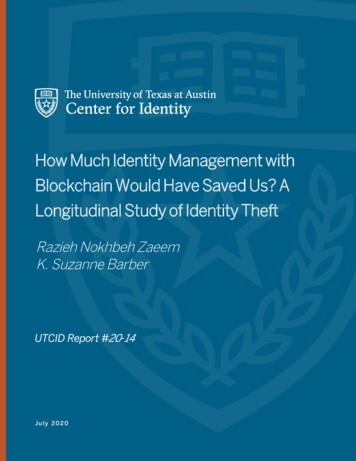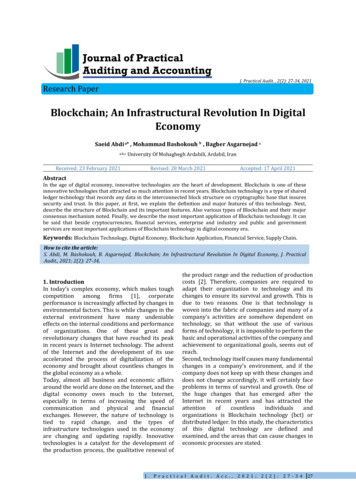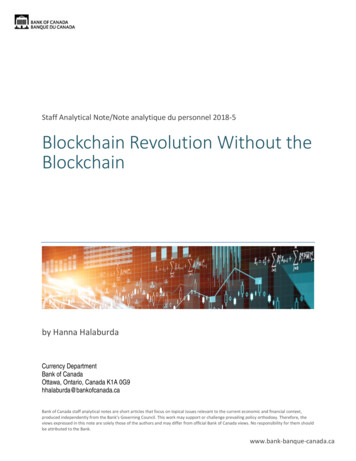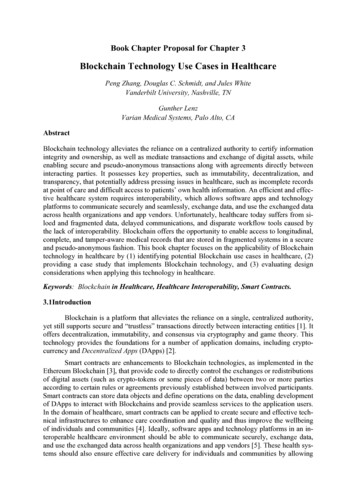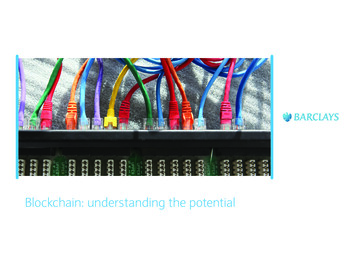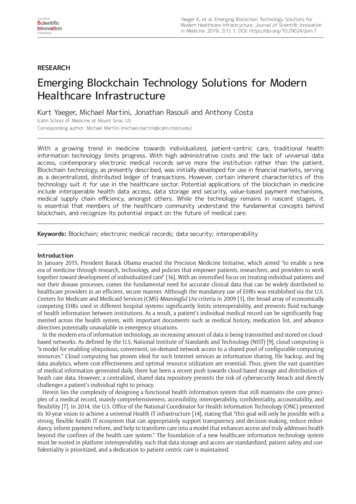
Transcription
Yaeger K, et al. Emerging Blockchain Technology Solutions forModern Healthcare Infrastructure. Journal of Scientific Innovationin Medicine. 2019; 2(1): 1. DOI: https://doi.org/10.29024/jsim.7RESEARCHEmerging Blockchain Technology Solutions for ModernHealthcare InfrastructureKurt Yaeger, Michael Martini, Jonathan Rasouli and Anthony CostaIcahn School of Medicine at Mount Sinai, USCorresponding author: Michael Martini (michael.martini@icahn.mssm.edu)With a growing trend in medicine towards individualized, patient-centric care, traditional healthinformation technology limits progress. With high administrative costs and the lack of universal dataaccess, contemporary electronic medical records serve more the institution rather than the patient.Blockchain technology, as presently described, was initially developed for use in financial markets, servingas a decentralized, distributed ledger of transactions. However, certain inherent characteristics of thistechnology suit it for use in the healthcare sector. Potential applications of the blockchain in medicineinclude interoperable health data access, data storage and security, value-based payment mechanisms,medical supply chain efficiency, amongst others. While the technology remains in nascent stages, itis essential that members of the healthcare community understand the fundamental concepts behindblockchain, and recognize its potential impact on the future of medical care.Keywords: Blockchain; electronic medical records; data security; interoperabilityIntroductionIn January 2015, President Barack Obama enacted the Precision Medicine Initiative, which aimed “to enable a newera of medicine through research, technology, and policies that empower patients, researchers, and providers to worktogether toward development of individualized care” [16]. With an intensified focus on treating individual patients andnot their disease processes, comes the fundamental need for accurate clinical data that can be widely distributed tohealthcare providers in an efficient, secure manner. Although the mandatory use of EHRs was established via the U.S.Centers for Medicare and Medicaid Services (CMS) Meaningful Use criteria in 2009 [1], the broad array of economicallycompeting EHRs used in different hospital systems significantly limits interoperability, and prevents fluid exchangeof health information between institutions. As a result, a patient’s individual medical record can be significantly fragmented across the health system, with important documents such as medical history, medication list, and advancedirectives potentially unavailable in emergency situations.In the modern era of information technology, an increasing amount of data is being transmitted and stored on cloudbased networks. As defined by the U.S. National Institute of Standards and Technology (NIST) [9], cloud computing is“a model for enabling ubiquitous, convenient, on-demand network access to a shared pool of configurable computingresources.” Cloud computing has proven ideal for such Internet services as information sharing, file backup, and bigdata analytics, where cost-effectiveness and optimal resource utilization are essential. Thus, given the vast quantitiesof medical information generated daily, there has been a recent push towards cloud-based storage and distribution ofheath care data. However, a centralized, shared data repository presents the risk of cybersecurity breach and directlychallenges a patient’s individual right to privacy.Herein lies the complexity of designing a functional health information system that still maintains the core principles of a medical record, mainly comprehensiveness, accessibility, interoperability, confidentiality, accountability, andflexibility [7]. In 2014, the U.S. Office of the National Coordinator for Health Information Technology (ONC) presentedits 10-year vision to achieve a universal Health IT infrastructure [14], stating that “this goal will only be possible with astrong, flexible health IT ecosystem that can appropriately support transparency and decision-making, reduce redundancy, inform payment reform, and help to transform care into a model that enhances access and truly addresses healthbeyond the confines of the health care system.” The foundation of a new healthcare information technology systemmust be rooted in platform interoperability, such that data storage and access are standardized, patient safety and confidentiality is prioritized, and a dedication to patient-centric care is maintained.
Art. 1, page 2 of 7Yaeger et al: Emerging Blockchain Technology Solutions for Modern Healthcare InfrastructureBlockchain TechnologyRecently, there has been intense focus on the development of blockchain-based technologies around the world. At itsmost elemental level, a “blockchain” is a decentralized, distributed leger of digital transactions that allows a trustlessexchange of money or data. In existing payment models, such as credit card, money order, or electronic (ex. PayPal)transactions, a third-party intermediary exists to facilitate exchange. Within a traditional transaction, the presence of acentralized institution, with inherent financial incentives, introduces the possibility of bias, dishonesty, and, ultimately,fraud. Furthermore, even with current financial technologies, the inefficient processes of transactional verification cantake days before money is withdrawn from one account and deposited in another. Considering these drawbacks to contemporary financial instruments, blockchain technology has developed over time to address the fundamental problemsof transactional trust, speed, and integrity.Initially described in 2009 by the anonymous individual or group known as Satoshi Nakamoto, the Bitcoin blockchain was developed as a peer-to-peer electronic cash system [10]. The blockchain functions by sequentially addingencrypted blocks of transactions to a chain, and simultaneously distributing the updated chain to specified nodesacross a network. Thus, since the updated blockchain is reliably distributed, the transactions within the individualblocks are immutable, and the integrity of the blockchain can be verified. Public identification keys are used betweenindividuals in a transaction, and the payer cryptographically signs transactions using a hidden private key, known onlyto the payer. Miners within a blockchain are nodes that construct blocks of transactions to be added to the chain, andare incentivized to work by collecting transaction fees. Thus, it is through the miners that a consensus blockchain isbuilt and distributed to the rest of the network.Since the origin of Bitcoin, other competing cryptocurrencies have emerged, each with a unique distributed leger oftransactions, but based on a variable blockchain code structure. Some blockchain technologies, such as Ethereum, allowspace in blocks to include “smart contracts,” or lines of code that define self-executing and/or self-enforcing clauses, running only if certain conditions are met. Most platforms have user-owned tokens that can be used to pay transaction costs,encode smart contracts, or transfer data between individuals on the blockchain. As these technologies have developedsignificant value in recent years, new platforms can use an “Initial Coin Offering (ICO)” to obtain early funding. These coinscan be publicly traded on cryptocurrency exchanges, an enigmatic financial sector which had a market capitalization ofover 800 billion in January 2018 [8]. Since peaking in value in January 2018, however, cryptocurrency exchanges have lostapproximately 80% of their value, reflecting overvaluation in the face of slow adoption by various economic industries [11].Regardless, the fundamental principle of a blockchain, mainly the anonymous, distributed ledger of transactions,remains relevant and still lends itself to certain technologic applications, such as distributed cloud storage, encrypteddigital identification, and decentralized payment strategies. Here, the parallels between blockchain technology and thecore needs of the modern health care infrastructure are apparent [4, 6, 13]. In the following section, we review severalpotential solutions that blockchain technologies address in the current health IT landscape.Blockchain Solutions in MedicineA summary of the benefits and drawbacks of the use of blockchain in healthcare can be visualized in Table 1.Table 1: Fundamental benefits and drawbacks of blockchain technology over contemporary financial systems.BENEFITSDecentralization Parties transact without a third-party intermediary, reducing financial bias and fraudTrustlessnessFinancial balances secured on the blockchain, payments made only when balance availableUser-centricityIndividuals, rather than institutions, in control of personal financial data; identity verificationTransparencyAll transaction data publicly available on the distributed ledgerImmutabilityDistributed ledger contains precise history of all prior transactions and balances, making alterations impossibleSpeedInefficient transaction verification process between financial institutions unnecessary; transactions processed 24/7SimplicitySingle distributed ledger contains all current balanace and transaction historiesCostRemoving intermediaries saves on transaction feesDRAWBACKSTechnologyBlockchain software is still in its infancy, continually being developed and refinedIntegrationMust initially be co-existent with current financial technologies, must be integrated overtimeCostAdoption of new technologies will incur initial greater costs to institutionsRegulationGovernment institutions have yet to settle regulatory concerns over blockchain technologyCultureAdoption of the technology will require significant buy-in from the global communityEnergyMaintaining the blockchain requires a network of nodes, and resulting substantial computing powerPrivacyEmerging cyber security concerns must be addressed before individuals will entrust data to a public blockchain
Yaeger et al: Emerging Blockchain Technology Solutions for Modern Healthcare InfrastructureArt. 1, page 3 of 7InteroperabilityCurrently, there exists a significant challenge distributing medical records across health care platforms, for e xample,between a nursing home and an acute care center or even between two independent hospitals (Figure 1). This leads to inefficiencies in health data collection and failures to communicate essential health information such as medicationsand allergies. However, by using novel technologies, a health system can assimilate an individual’s medical record intoa block, which can then be cryptographically stored in nodes across a distributed blockchain, accessed remotely bypermitted providers, and updated with new relevant medical information. This would obviate the need for patients tobring paper or electronic records to a new health care environment; they would simply allow the provider to access totheir medical data on the blockchain.Several platforms are currently being developed to address optimal interoperability of electronic health records. InAugust 2016, Ekblaw and coauthors from the MIT Media Lab proposed a novel, blockchain-based medical record management system called MedRec [3]. The system utilizes a system of smart contracts maintained on the Ethereum blockchain to link to an individual patient’s de-identified medical records. Once providers query the blockchain, with explicitpermission from the patient, HIPPA compliant data can be unencrypted and accessed from cloud storage, updated,and reincorporated into the blockchain. According to the MedRec whitepaper proposal, “blockchain implementationaddresses four major issues: fragmented, slow access to medical data; system interoperability; patient agency; andimproved data quality and quantity for medical research.” Several private institutions have begun development anddistribution of proprietary blockchain technologies, as outlined in Table 2.Medical record data compatibility has recently been addressed by a proposed standard called Fast HealthcareInteroperability Resources (FHIR), created and maintained by the group Health Level Seven International (HL7) [5].With the overall goal of facilitating the exchange of medical data across healthcare applications, the FHIR protocolcould be utilized as part of a blockchain infrastructure to break down data silos and securely share and distributemedical records. As summarized in a proposal by Peterson and colleagues from the Mayo Clinic, medical documentsFigure 1: Theoretical schematic of blockchain technology in healthcare. During a healthcare interaction, medicaldata is recorded via an institutional EMR platform, and the resulting encrypted meta-data is incorporated into anindividual “block”. This block is then presented to network participants for inclusion into the blockchain. Whena block is incorporated into the blockchain, the entire chain is immediately distributed to all participants in thenetwork, so that each has an identical copy of all data. The resulting blockchain is decentralized (no central authorityhas ownership), immutable (changing blockchain data at one node is immediately rejected by the consensus), andeasily accessible from any network participant.Source: Amy Zhong, Mount Sinai Health System.
Art. 1, page 4 of 7Yaeger et al: Emerging Blockchain Technology Solutions for Modern Healthcare InfrastructureTable 2: Emerging blockchain solutions in healthcare information technology. Platforms may be theoretical, indevelopment, or in current clinical use.CompanySolutionDescriptionAccenture(Dublin, Ireland)SecurityIn partnership with Microsoft, developing blockchain-based identificationsystem based on biometric data.Blockchain Health(San Francisco, USA)Data managementProvides HIPAA-compliant blockchain solutions for healthcare organizations;facilitates sharing of data with researchers.Blockpharma(Paris, France)Supply chainAccesses pharmaceutical company records, allowing transaction auditing.Bloq(Chicago, USA)Data managementOffers services for institutions to create, test, and apply custom blockchainsoulutions.Bowhead Health(Singapore)Patient-centric careBowhead device accesses blockchain data to accurately dispense medicationand track compliance.Burst IQ(Denver, USA)Data managementManages large HIPAA-compliant data repository; monetizes data sharing.Gem Health(Venice, CA, USA)Data managementHIPAA-compliant blockchain platform; allows secure access to sharable data.HealthCombix(Nashville, USA)Patient-centric care,value-based paymentsBlockchain platform prioritizing patient control of data; token-based payment system.Health Wizz(Falls Church, VA, USA)Patient-centric carePlatform allows patients to create a personal health portfolio; smart contracts allow payment for health data in cryptocurrency.iSolve(Sandton, South Africa)Supply chainOrganizes, schedules, and tracks delivery of medical devices and pharmaceuticals.MedicalChain(London, England)InteroperabilitySecure storage of medical data on the blockchain; patients permit access toindividual providers/institutions.Patientory(Atlanta, USA)InteroperabilityFacilitates interoperability of existing electronic medical record systems (ie.Epic, Cerner, Allscripts).PokitDok(San Mateo, CA, USA)Value-based payments,supply chainDokChain, a blockchain-based transaction ledger, focused on financial andsupply chain management.ScalaMed(Sydney, AustraliaData managementCreating a decentralized platform for managing financial and data transactions.would not be stored on the blockchain; rather, blockchain transactions may simply allow providers remote access toFHIR data [12].Data securitySeveral characteristics of a blockchain infrastructure allow for a more secure data maintenance and transfer system,compared to current standards [15]. First, the distributed ledger system fundamentally records an immutable historyof transactions. When a patient’s data is accessed, the event is incorporated into the permanent chain, which is thensimultaneously updated on all nodes across the network. Any unauthorized record change would not be built into theblockchain, due to lack of consensus amongst network nodes. Second, data within blocks are fundamentally encryptedwhen added to the chain, such that outside participants are unable to decipher data within. Third, transactions withina blockchain are authorized with a private identification key, known only to the individual. Thus, unlike the EMR technology of today, a medical provider would be able to access a patient’s medical data only with explicit access to theblockchain record.Value-based paymentsThe ability to encode smart contracts within various blockchain infrastructures permits a more efficient value-basedhealthcare payment model. An insurance payer, for example, may encode reimbursement for a physician to be fulfilledonly when certain conditions are met on the blockchain. In this instance, the common mistrust between physician andpayer is eliminated. Furthermore, software-encoded reimbursement or financial penalty can be tied to specific healthparameters within the blockchain medical record. As such, human error would be removed from enforcing value-basedpayments, and physicians would be more efficiently held responsible for improving patient care. With a blockchainbased medical record, all prior history, testing, and imaging would be accessible to providers, thus eliminating unnecessary redundancy in the medical workup.
Yaeger et al: Emerging Blockchain Technology Solutions for Modern Healthcare InfrastructureArt. 1, page 5 of 7Identity verificationMaintaining an immutable identification source using blockchain technology would have significant impact for bothpatients and practitioners. Similar to traditional identification verification, individuals will be able to have their identities confirmed using a combination of personal, government, and financial records. However, by leveraging blockchaintechnology, this verification can be stored and utilized in perpetuity. For patients, this can be used when attendingappointments or for pharmaceutical pick-up. For physicians, this can be used for licensing and credentialing verification, as well as transfer of license across state lines.Research and data managementWith big data, artificial intelligence, and machine learning emerging as revolutionary scientific instruments, a healthcare blockchain infrastructure could permit more effective medical research. With a large, standardized, de-identifieddata registry, research institutions could perform more significant clinical trials and prospective analyses. Amassingand analyzing information-heavy data sets, such as tumor genomics, would allow for a more personalized medicine.Interconnecting standardized medical data on the blockchain can permit this type of research with a high sample size.Furthermore, reporting of patient safety events and adverse drug reactions would be simplified and more accuratelycommunicated to providers and the general population. Lastly, with the greater use of wearable technology, personalhealth devices, and the Internet of Things (IoT), the generation of massive, patient-generated data sets can be incorporated into individual medical records, and further analyzed using a blockchain network.Patient-centric careAs opposed to existing EMR systems in which the medical data are controlled by the clinician, securing medical data onthe blockchain allows the patient to become the primary intermediary in distributing his or her medical information[2]. Here, with each new medical encounter, a patient or family member must explicitly permit the provider access tothe patient’s medical record, as regulated by the patient’s private key signature. Furthermore, every time a patient’sdata is accessed, the event is captured in the blockchain’s immutable transaction history, allowing the patient to knowwho has accessed and modified his or her record.Supply chain managementThe current global medical supply chain, consisting of pharmaceuticals, medical devices, and hospital goods, is fractionated and inefficient. Substandard, expired, or counterfeited products directly threaten patient care. A distributedledger technology permits several advantages over the current supply chain delivery. First, the blockchain maintainsan immutable record of available drugs and devices, preventing purchase of expired or counterfeit products. Second,it allows reliable tracking of transactions between hospital and supplier, leading to a greater cost-efficacy and accountability of hospital systems. Lastly, a blockchain infrastructure can be used to facilitate information sharing betweenhealthcare institutions and medical device or pharmaceutical companies, leading to a more effective feedback loopbetween providers and industry.Limitations of the Blockchain in HealthcareThe foundational benefit of a blockchain infrastructure is its shared, non-modifiable record of transactions. However,the fact that data is shared amongst all participants in a network may seem to undermine the necessary anonymity ofprotected health information (PHI). This can be addressed by incorporating only de-identified and encrypted data intothe blockchain. Whereas information in the blockchain itself is public, PHI stored in data repositories off the blockchainwould be heavily protected and HIPPA compliant. Again, accessing this data would only be permissible by the patient,using smart contracts and an anonymous private key to limit access to only specified clinicians. Managing this privatekey may prove difficult for the individual patient, especially for the elderly or disabled population, but precise biometriclinking to one’s key may obviate a physical record. Furthermore, maintaining a confidential private key is no different than protecting a social security number or institutional medical record number for medical data access. The truestrength of blockchain technology lies in its ability to confirm with complete certainty that a transaction or an eventhas taken place, without compromising the specific information of the event.Distributed data sharing requires a network of nodes to build and maintain the blockchain. This poses two problems.First, creating such a healthcare network requires significant buy-in from the medical community. Existing medicalsystems preserve the status quo, and a novel healthcare infrastructure may prove too expensive or difficult for widespread implementation. Second, maintaining a blockchain network requires significant computing power, which canlead to greater cost of hardware and energy consumption by a hospital system. In both cases, incentivizing participantsin the healthcare blockchain may lead to its greater utilization. Blockchain-based applications may distribute tokens toparticipants in the network, which can be exchanged for services such as increased data storage, faster data transfer, oraccess to a data repository. Tokens can also be traded for Bitcoin or U.S. dollars on a cryptocurrency exchange, allowingthe option for direct financial compensation.Lastly, as it stands now, private medical data is highly protected by both the individual and his or her medical institution. By claiming ownership over a large amount of health records, hospitals and practices monetize data sharing with
Art. 1, page 6 of 7Yaeger et al: Emerging Blockchain Technology Solutions for Modern Healthcare Infrastructureresearchers and industry partners (ex. clinical trials and public health studies). The movement towards decentralizeddata storage and distribution on a blockchain may encounter significant pushback by institutions that value medicaldata ownership. Fundamentally shifting the ownership of personal health records to the patient will require a philosophical paradigm shift in both health policy and law.ConclusionsIn the coming years, there will be revolutionary advances in the global health IT infrastructure. Emerging technologieswill serve to address issues with the current system, including the lack of interoperability of electronic health record(EHR) software, the inefficient and insecure transfer of protected health information (PHI), an ineffective paymentsystem for value-based care, and the evolving need for patient-centered care. Creating and implementing a blockchainbased healthcare network can address these problems in a revolutionary way. As novel technologies are developed, it isup to clinicians to maintain an accepting, yet inquisitive attitude, a willingness to implement new ideas, and a philosophy of feedback rather than absolute dismissal.Competing InterestsThe authors have no competing interests to declare.References1. (CMS) C for M and MS. Electronic Health Records (EHR) Incentive Programs; 2017. Available from: lation/EHRIncentivePrograms/index.html?redirect /ehrincentiveprograms [Last accessed 2017 Jul 16].2. Cunningham J and Ainsworth J. Enabling Patient Control of Personal Electronic Health RecordsThrough Distributed Ledger Technology. Stud Health Technol Inform. 2017; 245: 45–48. DOI: https://doi.org/10.3233/978-1-61499-830-3-453. Ekblaw A, Azaria A, Halamka JD and Lippman A. A Case Study for Blockchain in Healthcare: MedRec prototypefor electronic health records and medical research data; 2016. Available from: onc blockchainchallenge mitwhitepaper.pdf [Last accessed 2017 Jul 29].4. Fan K, Wang S, Ren Y, Li H and Yang Y. MedBlock: Efficient and Secure Medical Data Sharing Via Blockchain. JMed Syst. 2018; 42(8): 136. DOI: https://doi.org/10.1007/s10916-018-0993-75. Health Level Seven International. FHIR v3.0.1. 2017. Available from: https://www.hl7.org/fhir/overview.html[Last accessed 2017 Jul 30].6. Li H, Zhu L, Shen M, Gao F, Tao X and Liu S. Blockchain-Based Data Preservation System for Medical Data. J MedSyst. 2018; 42(8): 141. DOI: https://doi.org/10.1007/s10916-018-0997-37. Mandl KD, Szolovits P and Kohane IS. Public standards and patients’ control: how to keep electronic medicalrecords accessible but private. BMJ. 2001; 322(7281): 283–7. DOI: https://doi.org/10.1136/bmj.322.7281.2838. Marshall A. Combined Crypto Market Capitalization Races Past 800 Bln. CoinTelegraph. 2018 Jan 7. [onlineaccess at: ket-capitalization-races-past-800-bln lastaccessed 2017 Jun 6].9. Mell P and Grance T. The NIST Definition of Cloud Computing; 2011. Available from: cialpublication800-145.pdf [Last accessed 2017 Jul 16].10. Nakamoto S. Bitcoin: A Peer-to-Peer Electronic Cash System; 2009. Available from: www.bitcoin.org [Last accessed2017 Jul 16].11. Patterson, M. Crypto’s 80% Plunge Is Now Worse Than the Dot-Com Crash. Bloomberg; 2018 Sep 12. [onlineaccess at: sses-reach-80 last accessed 2018 Oct 23].12. Peterson K, Deeduvanu R, Kanjamala P, Boles K and Clinic M. A Blockchain-Based Approach to HealthInformation Exchange Networks; 2017. Available from: blockchain-based-approach-final.pdf [Last accessed 2017 Jul 30].13. Radanović I and Likić R. Opportunities for Use of Blockchain Technology in Medicine. Appl Health Econ HealthPolicy. 2018; 16(5): 583–590. DOI: https://doi.org/10.1007/s40258-018-0412-814. The Office of the National Coordinator for Health IT. Connecting Health and Care for the Nation: A Ten YearVision to Achieve Interoperable Health IT Infrastructure; 2014. Available from: yearInteroperabilityConceptPaper.pdf [Last accessed 2017 Jul 16].15. Wang H and Song Y. Secure Cloud-Based EHR System Using Attribute-Based Cryptosystem and Blockchain. J MedSyst. 2018; 42(8): 152. DOI: https://doi.org/10.1007/s10916-018-0994-616. White House O of the PS. Precision Medicine Initiative. The White House Archives. 2015. Available from: icine [Last accessed 2017 Jul 16].
Yaeger et al: Emerging Blockchain Technology Solutions for Modern Healthcare InfrastructureArt. 1, page 7 of 7How to cite this article: Yaeger K, Martini M, Rasouli J and Costa A. Emerging Blockchain Technology Solutions for ModernHealthcare Infrastructure. Journal of Scientific Innovation in Medicine. 2019; 2(1): 1. DOI: https://doi.org/10.29024/jsim.7Submitted: 26 October 2018Accepted: 04 January 2019Published: 24 January 2019Copyright: 2019 The Author(s). This is an open-access article distributed under the terms of the Creative CommonsAttribution 4.0 International License (CC-BY 4.0), which permits unrestricted use, distribution, and reproduction in any medium,provided the original author and source are credited. See l of Scientific Innovation in Medicine is a peer-reviewed open access journalpublished by Levy Library Press.OPEN ACCESS
Art. 1, page 2 of 7 Yaeger et al: Emerging Blockchain Technology Solutions for Modern Healthcare Infrastructure Blockchain Technology Recently, there has been intense focus on the development of blockchain-based technologies around the world.

